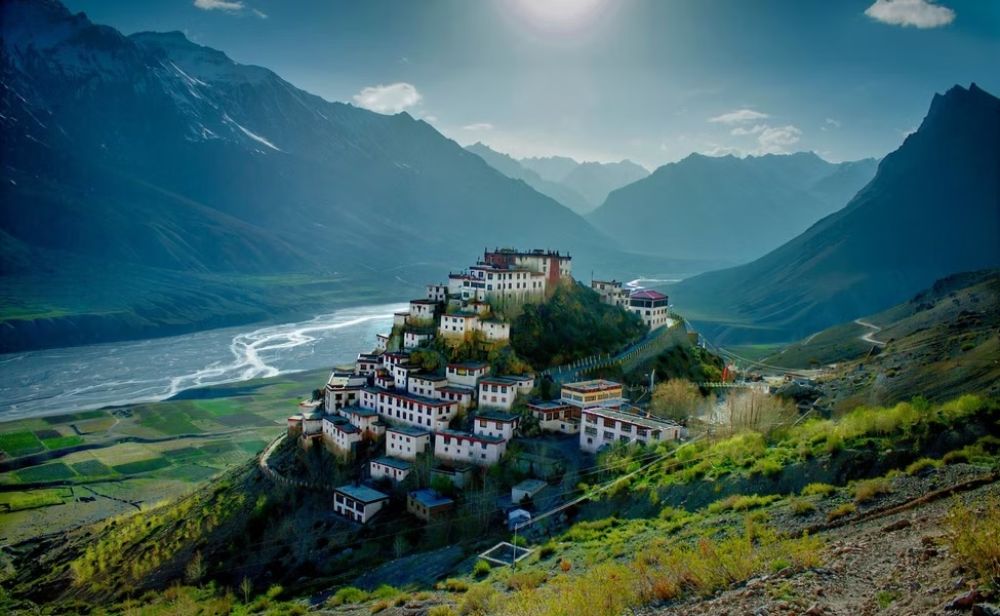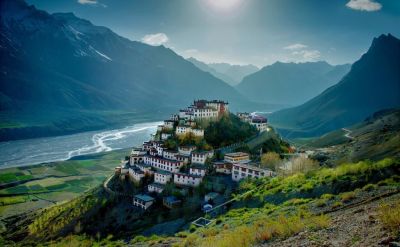

Nestled at an altitude of about 4,300 meters in the Himalayas, Chandratal Lake is a popular trekking destination in Spiti Valley, Himachal Pradesh. The name 'Chandratal' translates to 'Moon Lake' due to its crescent shape, and it is renowned for its stunning beauty and the crystal-clear waters that reflect the surrounding Himalayan peaks. Trekking to this lake is a thrilling experience, giving adventurers a glimpse of the arid desert landscapes of Spiti, along with lush meadows, wildflowers, and panoramic views of snow-capped mountains. The trek is relatively demanding, traversing rocky terrains, moraines, and steep climbs, thus it is recommended for those with good physical fitness and some prior trekking experience. Along the way, trekkers can spot a variety of wildlife and experience the serene solitude of the high-altitude terrain. The journey to Chandratal Lake is not just an adventure but also a way to connect with nature and experience the unique culture of the Spiti Valley.
Perched atop a hill at an altitude of 4,166 meters, Key Monastery is over a thousand years old, making it an important center for Buddhist learning and culture in the region. This iconic monastery stands as a testament to the resilience of the people and their dedication to their spiritual traditions. The architecture of the monastery is a stunning representation of the monastic architecture which developed in the Spiti Valley under the influence of Chinese Buddhist art. Visitors can explore the ancient murals, thangkas, and religious texts housed within the monastery walls. The serene ambiance and meditative environment also attract travelers seeking tranquility and insight into the monastic way of life. Moreover, interacting with the resident lamas and observing their daily rituals provide a unique cultural experience that is both enriching and humbling.
Pin Valley National Park, located in the cold desert region of Spiti, offers visitors stunning landscapes of the high altitude Himalayan valley. Established in 1987, the park is home to the endangered Snow Leopard and other alpine animals like the Siberian Ibex, Tibetan Gazelle, Red Fox, and various species of birds. The park is characterized by its stark beauty, with towering snowy peaks surrounding the valley, glaciers, and jagged rock formations. Despite the seemingly harsh conditions, the valley blooms with vibrant life, including several unique species of plants that have adapted to the high altitude and arid climate. Visitors often go on safari drives or guided treks to spot the rich wildlife and take in the breathtaking vistas that the park offers. The natural elegance and tranquility of the park offer a truly unparalleled wilderness experience.
Kaza, the administrative headquarters of the Spiti Valley, serves as a base for excursions throughout the region. Nestled among high mountains, it presents visitors with an opportunity for an ideal camping experience. Camping in Kaza can be a unique way to experience the rugged terrain, raw beauty, and starry skies of the Spiti Valley. Campsites typically provide basic amenities and can range from luxurious glamping spots with equipped tents to more rustic and self-sufficient setups. The chilly nights spent around a bonfire, sharing tales, and gazing at the Milky Way are experiences that embed themselves in the memories of travelers. With the Spiti River flowing nearby, the sound of water adds a tranquil backdrop to a night of camping. The region's remoteness and the clear skies also make it an excellent spot for astrophotography and stargazing.
Mountain biking in Spiti Valley is an adrenaline-pumping activity for cycling enthusiasts looking to test their mettle. Given the challenging terrain, with high-altitude trails, steep ascents, and rock-strewn paths, it is recommended for experienced bikers. Biking through the valley affords views of the sparse yet striking landscape, dotted with small villages, ancient monasteries, and unique geological formations. The route often includes passes such as Kunzum La and Rohtang Pass, adding to the thrill of the experience. Mountain biking in Spiti not only pushes one's physical boundaries but also offers the chance to engage with the local culture, as cyclists pass through various communities along the way. Despite the tough conditions, the exhilaration of conquering the rough terrains of Spiti on two wheels is a reward worth the effort.
A Yak Safari is a unique and traditional mode of transport in the high altitudes of Spiti Valley, offering an unusual and relaxed way of exploring the rugged landscape. Yaks, known for their ability to navigate easily through the rough terrain of the region, provide a steady ride for visitors. A ride on these gentle giants allows for a closer look at inaccessible parts of the valley, without the exhaustion of trekking. The pace of the safari is slow and gives ample time for travelers to absorb the serene beauty of the Spiti Valley. Guests are often treated to close-up views of the local flora and fauna. Furthermore, the Yak Safari is not just an adventure; it's a cultural immersion, giving travelers a glimpse into the traditional ways of life in Spiti where yaks are an integral part of local livelihoods.
Dhankar Lake provides a serene trekking opportunity for those visiting Spiti Valley. The starting point of the trek is Dhankar Monastery, which is located in the village of Dhankar – the traditional capital of the Spiti Kingdom. Set against a stark backdrop of barren, rugged mountainscapes, the trek to Dhankar Lake is a fairly steep climb that takes about an hour and a half each way. The lake itself is a small, beautiful body of water that appears as a brilliant blue oasis amongst the craggy desert terrain. It is considered sacred by the locals and is a perfect place for tranquility and reflection. The trekking route affords trekkers panoramic views of the surrounding valley and villages in the vicinity. Notably, the Dhankar Monastery is also a must-visit site, with its ancient fort and temple offering insights into the rich heritage of Spiti Valley.
Spiti Valley, with its otherworldly landscapes, ancient monasteries, and unique culture, is a photographer's paradise. Embarking on a photography tour across this high-altitude cold desert offers endless opportunities to capture the ethereal beauty of nature and the vibrant culture of its people. Professional and amateur photographers alike can find abundant subject matter in the dramatic play of light and shadow over the rugged mountains, the intricate frescoes and architecture of monasteries like Tabo and Ki, and the faces of the warm and resilient locals. These tours are usually led by professional photographers who provide guidance on how to make the most out of the available light and compositions. They also include visits to the most photogenic locations at the right times to capture the best shots.
White water rafting on the Spiti River offers an exhilarating experience for adventure enthusiasts. The Spiti River snakes through the deep valleys and gorges of the region, providing a rugged and challenging course for rafters. Offering a range of rapids from Grade II to IV, rafting in Spiti is suitable for both novices and experienced rafters. The river's cold and clear waters, set against a landscape of high cliffs and stark beauty, make for an unforgettable journey. The activity is not just about the thrill of navigating the rapids, however. It also enables participants to witness the grandeur of Spiti's landscapes from a unique vantage point, with opportunities to spot wildlife along the riverbanks. Safety is paramount, and all rafting trips are conducted by skilled instructors, equipped with the necessary safety gear.
Staying with a local family in a homestay provides an opportunity for an immersive cultural experience in Spiti Valley. Spitian homes are built in the traditional Tibetan style and offer simple yet comfortable accommodations. Families often welcome guests with warmth and hospitality, sharing their homes and way of life. Through a homestay, visitors can participate in daily activities like farming, cooking, and learning about local crafts and customs. Meals are typically home-cooked, providing an authentic taste of Spitian cuisine, which includes staples like thukpa and momos. A homestay also supports the local economy and gives travelers a chance to gain a deeper understanding of the community’s lifestyle, challenges, and vibrant cultural traditions in this remote part of the world.
